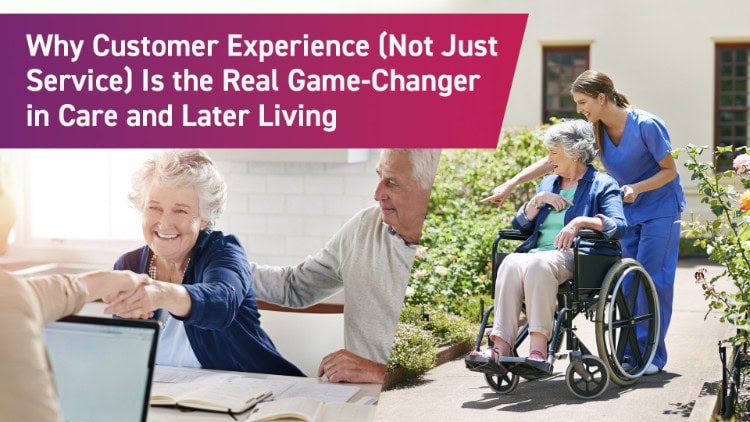In this article we explore the pros, the pitfalls – and how to get it right.
For families and potential residents navigating care decisions, time and clarity matter. They might be visiting your website late at night after a long day, or during a lunch break in the middle of a crisis. And while a friendly voice at the end of the phone is always reassuring, sometimes it’s not practical in the moment.
That’s where live chat comes in.
It’s fast becoming a feature on many care home and later living community websites, offering an instant way for people to ask questions, check availability, or simply get some reassurance.
But is it the right fit for everyone?
Let’s take a closer look.
Why Live Chat Can Work Brilliantly
1. It offers instant connection
Live chat can provide quick answers to simple but important questions – like visiting hours, room availability, or how to arrange a tour. For someone feeling overwhelmed or emotional, that instant access can bring real comfort.
2. It’s mobile-friendly
With so many people using their phones to search for later living and care options, live chat makes it easy to get in touch without scrolling for contact details or filling in long forms.
3. It creates a warm first impression
Handled with care, live chat can reflect your tone of voice and values. A compassionate, helpful message (“You’re not alone – let’s see how we can support you”) sets the tone for everything that follows.
And when there’s a real human on the other end, someone knowledgeable, who understands both the emotional weight of the decision and the practical realities, live chat becomes more than just a tech tool. It becomes a lifeline. That early connection can build trust in seconds and gently guide potential residents and families alike toward the next step with confidence.
4. It supports website performance and SEO
While live chat doesn’t directly boost your Google ranking, it can improve your website’s performance. If people stay longer, engage more, and find what they need quickly, it sends a positive signal to search engines. It also helps reduce bounce rates – making visitors more likely to become enquiries.
5. It increases enquiries
Live chat can gently nudge people who aren’t ready to make a call. A short message (“Can I help you find something?”) might be all it takes for someone to reach out. That moment can lead to a viewing – and potentially a move-in.
6. It gives your team insight
Live chat gives you a front-row seat to what families are really asking. Whether it’s questions about pets, food, visiting hours or funding – these conversations can help shape your FAQs, social content, and follow-up materials.
7. It helps personalise your follow-up
If someone shares a little background – “My dad’s just come out of hospital” – you’ve got context when you call. That kind of detail helps your team follow up with warmth and relevance, rather than a generic sales pitch.
8. It offers choice – and avoids missed opportunities
Not everyone wants to pick up the phone straight away. Some people feel more comfortable starting a conversation in writing, at their own pace, without the pressure of a live call. Live chat gives those people a way in – a gentle first step.
Without it, you risk missing enquiries from those who do want to connect, just in a different way. Offering live chat is about meeting people where they are, and that flexibility can make all the difference.
When Live Chat Misses the Mark
1. If it feels robotic or cold
Generic or scripted replies can quickly undo the sense of trust you’ve worked so hard to build. Families and potential residents want to feel seen, not sent in circles.
2. If it’s managed by someone without knowledge
Outsourcing to third parties who don’t understand your service can result in confusing or unhelpful answers.
3. If it creates more frustration
A chat that leads nowhere – no follow-up, no contact details taken – can leave people feeling ignored. That moment of need becomes a missed opportunity.
4. If it raises privacy concerns
If someone shares sensitive personal information, you need to be confident your system is secure and compliant. Staff also need to know what not to say and when to escalate.
Making Live Chat Work for You
If you’re considering live chat, here are a few ways to make it feel like an extension of your values – not a bolt-on feature.
- Be transparent. Let users know if they’re speaking to a real team member or a chatbot.
- Use your tone of voice. Warm, human, and helpful should always be the goal.
- Set expectations. Include your hours of availability, or what happens when someone leaves a message.
- Make follow-up easy. Ask for a name and preferred contact method so you can respond properly – and don’t leave messages unanswered.
- Train your team. Equip whoever’s managing the chat with the knowledge and sensitivity they need.
- Add a human face. A simple photo and name – “Hi, I’m Lucy. Let me know if I can help” – can make it feel far more welcoming.
Final Thoughts
Live chat can be a helpful bridge between your website and your team, if it’s handled well. It’s not about being available 24/7, but about making those first few minutes of contact feel personal, warm, and supportive.
Because for the families you’re trying to reach, it’s never ‘just’ a chat. It’s often the beginning of a very big decision.
Need help deciding if live chat is right for your care home or later living community?
At Commercial Acceleration, we help operators turn online interest into real-world relationships and real move-ins. From auditing your current enquiry journey to refining your website’s calls to action (including live chat), we’ll work with you to create a seamless, human-first experience that builds trust, increases visits, and ultimately drives occupancy.
Get in touch to explore what’s working – and what could work better.

